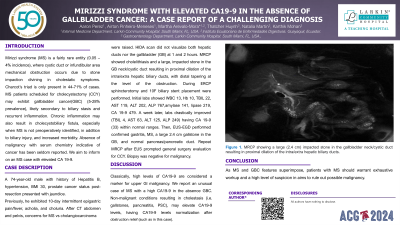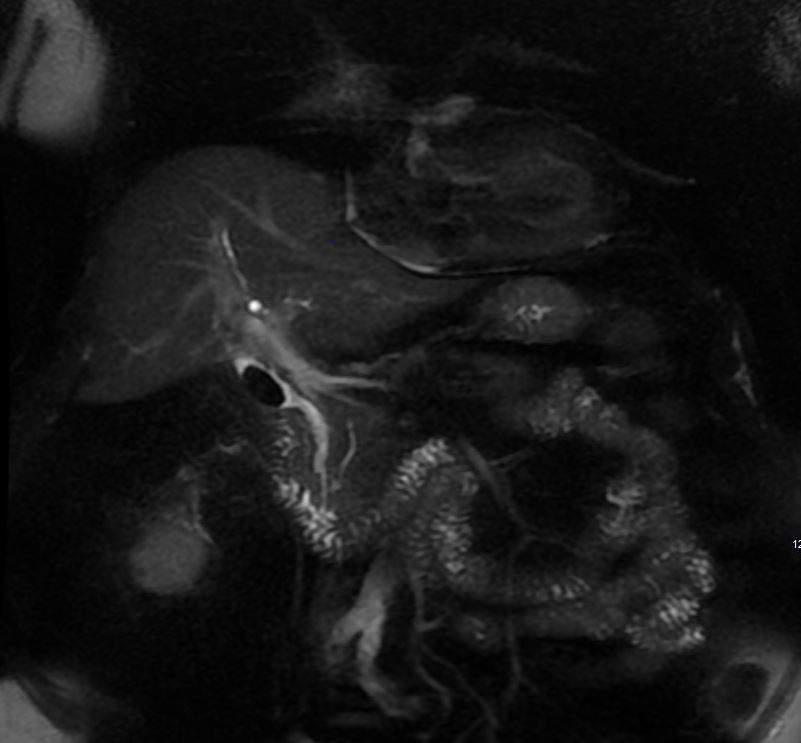Sunday Poster Session
Category: Biliary/Pancreas
P0094 - Mirizzi Syndrome With Elevated CA19-9 in the Absence of Gallbladder Cancer: A Case Report of a Challenging Diagnosis
Sunday, October 27, 2024
3:30 PM - 7:00 PM ET
Location: Exhibit Hall E

Has Audio
- AP
Aaron Perez, DO
Larkin Community Hospital
South Miami, FL
Presenting Author(s)
Aaron Perez, DO1, Airton Pinheiro-Meneses, MD1, Martha Arevalo-Mora, MD1, Thatcher Huynh, DO1, Natalia Martin, DO1, Karthik Mohan, DO2
1Larkin Community Hospital, South Miami, FL; 2Larkin Community Hospital, Hialeah, FL
Introduction: Mirizzi syndrome (MS) is a fairly rare entity (0.05 – 4% incidence), where cystic duct or infundibular area mechanical obstruction occurs due to stone impaction divining in cholestatic symptoms. Charcot’s triad is only present in 44-71% of cases. MS patients scheduled for cholecystectomy (CCY) may exhibit gallbladder cancer (GBC) (5-28% prevalence), likely secondary to biliary stasis and recurrent inflammation. Chronic inflammation may also result in cholecystobiliary fistula, especially when MS is not preoperatively identified, in addition to biliary injury, and increased morbidity. Absence of malignancy with serum chemistry indicative of cancer has been seldom reported. We aim to inform on an MS case with elevated CA 19-9.
Case Description/Methods: A 74-year-old male with history of Hepatitis B, hypertension, BMI 30, prostate cancer status post-resection presented with jaundice. Previously, he exhibited 10-day intermittent epigastric pain/fever, acholia, and choluria. After CT abdomen and pelvis, concerns for MS vs cholangiocarcinoma were raised. HIDA scan did not visualize both hepatic ducts nor the gallbladder (GB) at 1 and 2 hours. MRCP showed cholelithiasis and a large, impacted stone in the GB neck/cystic duct resulting in proximal dilation of the intra/extra hepatic biliary ducts, with distal tapering at the level of the obstruction. During ERCP sphincterotomy and 10F biliary stent placement were performed. Initial labs showed WBC 13, Hb 10, TBIL 22, AST 119, ALT 202, ALP 767, amylase 141, lipase 219, CA 19-9 479. A week later, labs drastically improved (TBIL 4, AST 63, ALT 125, ALP 249) having CA 19-9 (33) within normal ranges. Then, EUS-EGD performed confirmed gastritis, MS, a large 2.4 cm gallstone in the GB, and normal pancreas/pancreatic duct. Repeat MRCP after EUS prompted general surgery evaluation for CCY. Biopsy was negative for malignancy.
Discussion: Classically, high levels of CA19-9 are considered a marker for upper GI malignancy. We report an unusual case of MS with a high CA19-9 in the absence GBC. Non-malignant conditions resulting in cholestasis (i.e. gallstones, pancreatitis, PSC), may elevate CA19-9 levels, having CA19-9 levels normalization after obstruction relief (such as in this case). As MS and GBC features superimpose, patients with MS should warrant exhaustive workup and a high level of suspicion in aims to rule out possible malignancy.

Disclosures:
Aaron Perez, DO1, Airton Pinheiro-Meneses, MD1, Martha Arevalo-Mora, MD1, Thatcher Huynh, DO1, Natalia Martin, DO1, Karthik Mohan, DO2. P0094 - Mirizzi Syndrome With Elevated CA19-9 in the Absence of Gallbladder Cancer: A Case Report of a Challenging Diagnosis, ACG 2024 Annual Scientific Meeting Abstracts. Philadelphia, PA: American College of Gastroenterology.
1Larkin Community Hospital, South Miami, FL; 2Larkin Community Hospital, Hialeah, FL
Introduction: Mirizzi syndrome (MS) is a fairly rare entity (0.05 – 4% incidence), where cystic duct or infundibular area mechanical obstruction occurs due to stone impaction divining in cholestatic symptoms. Charcot’s triad is only present in 44-71% of cases. MS patients scheduled for cholecystectomy (CCY) may exhibit gallbladder cancer (GBC) (5-28% prevalence), likely secondary to biliary stasis and recurrent inflammation. Chronic inflammation may also result in cholecystobiliary fistula, especially when MS is not preoperatively identified, in addition to biliary injury, and increased morbidity. Absence of malignancy with serum chemistry indicative of cancer has been seldom reported. We aim to inform on an MS case with elevated CA 19-9.
Case Description/Methods: A 74-year-old male with history of Hepatitis B, hypertension, BMI 30, prostate cancer status post-resection presented with jaundice. Previously, he exhibited 10-day intermittent epigastric pain/fever, acholia, and choluria. After CT abdomen and pelvis, concerns for MS vs cholangiocarcinoma were raised. HIDA scan did not visualize both hepatic ducts nor the gallbladder (GB) at 1 and 2 hours. MRCP showed cholelithiasis and a large, impacted stone in the GB neck/cystic duct resulting in proximal dilation of the intra/extra hepatic biliary ducts, with distal tapering at the level of the obstruction. During ERCP sphincterotomy and 10F biliary stent placement were performed. Initial labs showed WBC 13, Hb 10, TBIL 22, AST 119, ALT 202, ALP 767, amylase 141, lipase 219, CA 19-9 479. A week later, labs drastically improved (TBIL 4, AST 63, ALT 125, ALP 249) having CA 19-9 (33) within normal ranges. Then, EUS-EGD performed confirmed gastritis, MS, a large 2.4 cm gallstone in the GB, and normal pancreas/pancreatic duct. Repeat MRCP after EUS prompted general surgery evaluation for CCY. Biopsy was negative for malignancy.
Discussion: Classically, high levels of CA19-9 are considered a marker for upper GI malignancy. We report an unusual case of MS with a high CA19-9 in the absence GBC. Non-malignant conditions resulting in cholestasis (i.e. gallstones, pancreatitis, PSC), may elevate CA19-9 levels, having CA19-9 levels normalization after obstruction relief (such as in this case). As MS and GBC features superimpose, patients with MS should warrant exhaustive workup and a high level of suspicion in aims to rule out possible malignancy.

Figure: MRCP showing a large (2.4 cm) impacted stone in the gallbladder neck/cystic duct resulting in proximal dilation of the intra/extra hepatic biliary ducts.
Disclosures:
Aaron Perez indicated no relevant financial relationships.
Airton Pinheiro-Meneses indicated no relevant financial relationships.
Martha Arevalo-Mora indicated no relevant financial relationships.
Thatcher Huynh indicated no relevant financial relationships.
Natalia Martin indicated no relevant financial relationships.
Karthik Mohan indicated no relevant financial relationships.
Aaron Perez, DO1, Airton Pinheiro-Meneses, MD1, Martha Arevalo-Mora, MD1, Thatcher Huynh, DO1, Natalia Martin, DO1, Karthik Mohan, DO2. P0094 - Mirizzi Syndrome With Elevated CA19-9 in the Absence of Gallbladder Cancer: A Case Report of a Challenging Diagnosis, ACG 2024 Annual Scientific Meeting Abstracts. Philadelphia, PA: American College of Gastroenterology.
